Abstract
This article is meant to serve as a general overview guide to the breeds of sheep that are most likely to have success in surviving in the harsh Florida climate. It is up to the producer to determine their preferences and goals and to select which breed among those mentioned in this article is most likely to meet their needs and goals. There are differences between genetic lines of breeds that can influence success; even so, the breeds mentioned in this article generally meet the necessary criteria to survive and thrive in Florida.
Introduction
Each breed of sheep is derived from genetic components that combine to make up certain traits and qualities individuals within each breed consist of. This translates into the phenotype and genotype carried and passed onto the next generation. The question of which breed (or type) of sheep one might choose to raise is important. Categories of the primary purpose of sheep breeds include meat, wool, and dairy. The producer’s goals will directly influence which breed they select for production. There are over 1,000 breeds of sheep worldwide, but only a few are likely suitable for successful production in Florida.
Florida’s wet and humid subtropical climate tends to be quite harsh and presents challenges for sheep to survive in these extreme conditions without intervention. In addition to the ability to adapt to this climate, sheep must also be able to withstand or resist the burden of Haemonchus contortus, the primary gastrointestinal parasite in small ruminants. Haemonchus thrives in warm, moist climates like that of Florida. Management of Haemonchus contortus is beyond the scope of this article; however, identifying sheep breeds that possess innate parasite resistance abilities and an ability to survive and grow in this environment is desirable. This is also in part due to the immense problem facing the small ruminant industry: widespread resistance to anthelmintic dewormers. This is critical because an individual possessing innate parasite resistance allows for decreased utilization of anthelmintic dewormers, due to their natural ability to keep their parasite burden low without intervention.
There are many meat breeds of sheep represented throughout Florida. Of those breeds, six are important for meat production and demonstrate some ability to naturally minimize their Haemonchus contortus burden. Those include American and Barbados Blackbelly, Dorper, Florida Cracker/Florida Native, Katahdin, St. Augustine, and St. Croix.
American Blackbelly and Barbados Blackbelly
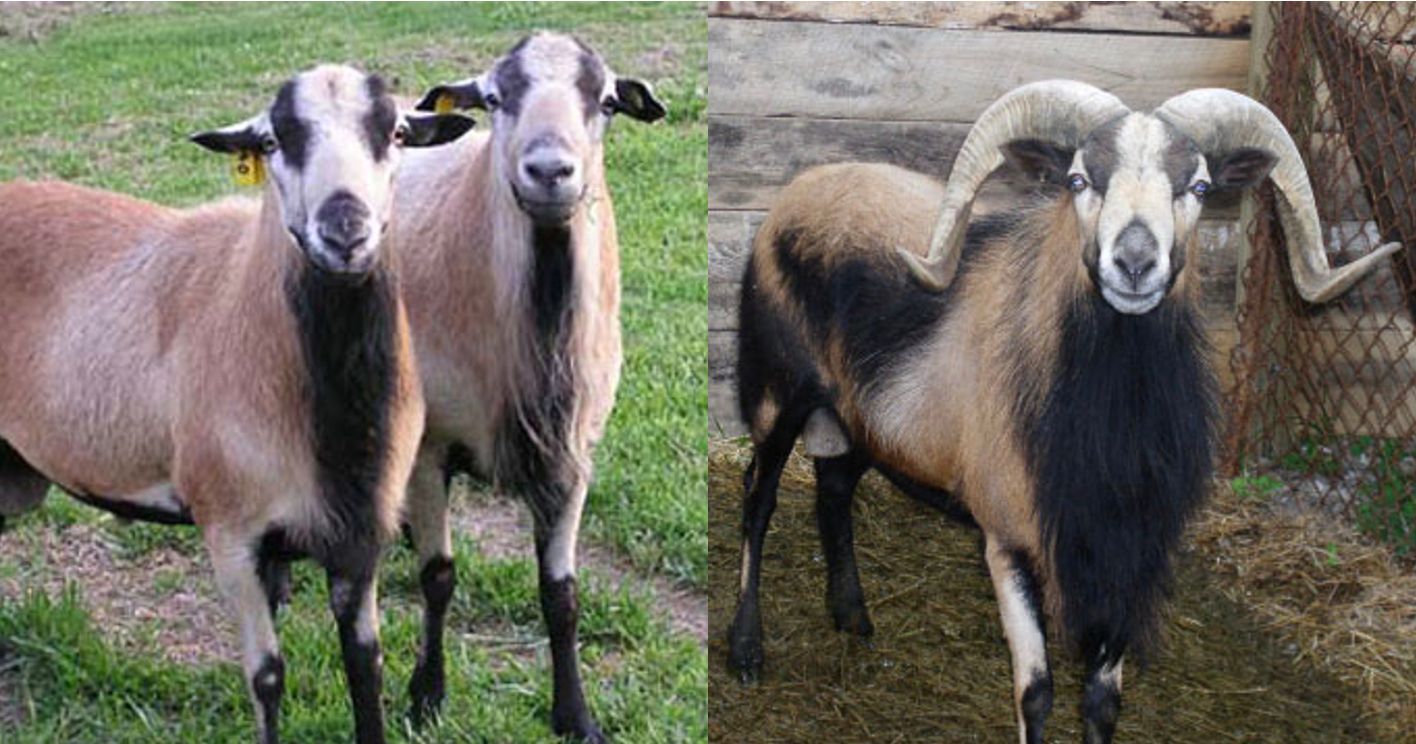
Credit: Barbados Blackbelly Sheep Association International
The Barbados Blackbelly breed was originally developed on the West Indies Island of Barbados from hair sheep brought in by slave traders during the 1600s (Combs 1983). The Barbados Blackbelly has a small frame; the American Blackbelly was created through crossbreeding of the Rambouillet and the European Mouflon to develop a larger meat sheep. American Blackbelly rams have prominent horns, while ewes generally are polled (hornless). The sheep also have a distinctive hair coat ranging from tan to brown to red, with distinctive black markings along the underline. This breed is known for its productivity, thriftiness, and low maintenance; the ewes make great mothers. The Barbados Blackbelly Sheep Association International has registered American Blackbelly sheep since 1996. The American Blackbelly is adaptable to many management programs and environments due to its foraging capabilities.
Size: Small.
Appearance: Typically ranges from tan to brown to red, with distinct black markings. Hair sheep (no wool).
Horns: Barbados—polled, no horns; American—horned.
Behavior: Alert, often nervous. Great flock instincts.
Breeding season: Out-of-season (all year).
Primary purpose: Meat.
Attributes: Lambs often grow slower compared to other breeds; however, minimal intervention is generally needed. Small, lean carcasses that may be attractive to the grass-fed markets.
Dorper
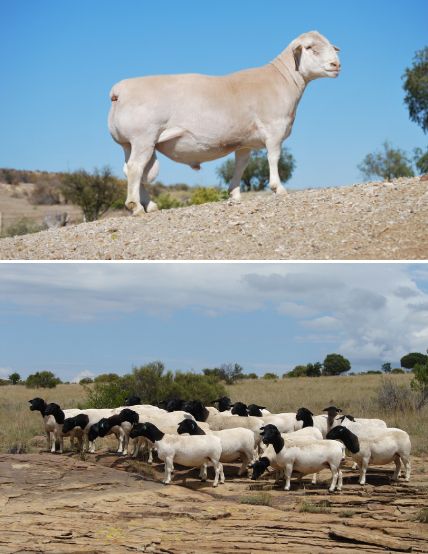
Credit: Dorper Sheep Breeders’ Society of South Africa
The Dorper breed was developed in South Africa through crossing Blackhead Persian ewes and Dorset Horn rams. The Blackhead Persian sheep is a fat-tailed desert breed from Arabia. They are known for hardiness, thriftiness, fertility, pigmentation, and hair covering. The Dorset Horn rams crossed with Blackhead Persian ewes were found to produce fast-growing and heavily muscled lambs with excellent carcass quality. The Blackhead Persian influence gives Dorpers a natural tolerance to high temperatures and heavy insect populations. The Dorper breed is known for its hardiness, adaptability, and exceptional growth (Milne 2000).
Size: Medium to large.
Appearance: White bodies and either a white (white Dorper) or black (black Dorper) head. Commonly has a mix of both hair and wool, typically shed out in the spring—does not require shearing.
Horns: Polled (no horns).
Behavior: Strong maternal instincts.
Breeding season: Long breeding season; can breed out of season (up to every 8 months, under intensive management).
Primary purpose: Meat.
Attributes: Fast-growing and well-muscled lambs, often used as a terminal sire. May require more intensive monitoring for parasite burden compared to other breeds mentioned in this article. High levels of performance may require additional nutritional considerations.
Florida Cracker/Florida Native

Credit: Florida Cracker Sheep Association
Florida Cracker or Florida Native sheep could be the oldest sheep breed in North America. It is believed that they developed from sheep first brought to Florida by the Spanish in the 1500s. The sheep developed mostly through natural selection under the humid, subtropical range conditions of Florida to be resistant to parasites. They can survive heat and humidity as well as cold, high winds, poor forage, and drought. They are hardy, parasite resistant, and pest resistant. The breed is low maintenance, and lambs with ease. They typically have wool on their bodies and shorter hair on their legs, belly, and head to behind their ears. This breed is known for its strong parasite resistance, high lamb survivability, heat tolerance, excellent mothering instincts, mild meat flavor, and good flocking ability. Florida Native sheep are also currently on the critically endangered list of livestock (The Livestock Conservancy 2020).
Size: Small.
Appearance: Brown to white face and lower limbs with primarily white wool.
Horns: Usually polled (no horns).
Behavior: Alert, docile.
Breeding season: Long breeding season, still short-day breeders.
Primary purpose: Meat, wool.
Attributes: Strong natural resistance to parasites, heat tolerance, strong maternal instincts. Lambs often are slow growing, and their carcass traits are historically inferior to other meat breeds (small and lean).
Katahdin
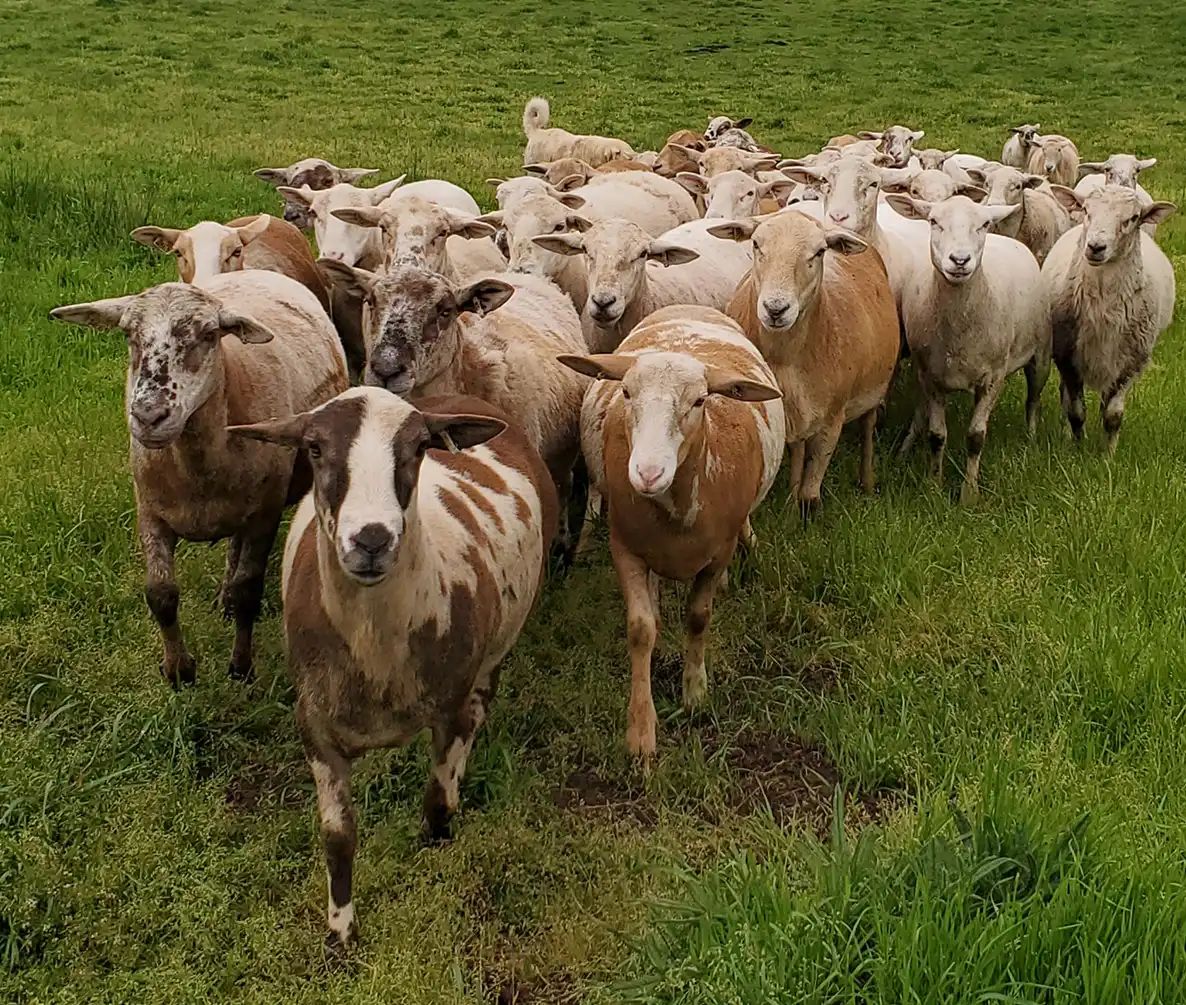
Credit: Katahdin Hair Sheep International
The Katahdin breed is known to be a hardy, adaptable, and low-maintenance hair sheep that was developed in the United States. These sheep produce superior lambs with a high-quality, well-muscled carcass that is naturally lean and consistently has a very mild flavor. It is a medium-sized breed bred for production in various management systems. Ewes have exceptional mothering abilities and lamb easily; lambs are known to be born vigorous and alert.
Katahdin sheep were derived from breeds that originated in the Caribbean and British Islands. The breed originated in Maine due to crossbreeding hair sheep from the Caribbean and numerous British sheep, specifically Suffolk. After nearly 20 years of crossbreeding, the Katahdin breed was founded by Michael Piel. In the 1970s, the Wiltshire Horn sheep was also incorporated into the breed to add size and improve carcass characteristics. Their smooth hair coat and other adaptations allow them to tolerate heat and humidity well. Katahdin sheep are known for their tolerance of internal and external parasites and, with proper management, generally require only minimal parasite treatment. This breed is known to be docile and easily handled, and it exhibits moderate flocking instinct. Katahdin ewes and rams exhibit early puberty as well as longevity. Mature ewes usually have twins, occasionally producing triplets or quadruplets.
Extensive ongoing research is being conducted to establish estimated breeding values (EBV) and genomically enhanced breeding values (GEBV) for the purposes of Katahdin selection in reference to many characteristics, such as parasite resistance, growth parameters, and more (Nilson et al. 2024). Pedigree records are accessible to participating producers through the National Sheep Improvement Program (NSIP 2015).
Size: Medium (largest of hair breeds).
Appearance: Various color patterns, hair (no wool) that ranges in texture and length. May have a woolly undercoat that sheds out in the spring/summer.
Horns: Polled (no horns).
Behavior: Strong maternal instincts; docile; moderate flocking instincts.
Breeding season: Long breeding season, still short-day breeders.
Primary purpose: Meat.
Attributes: Adaptable to different environments in that they can grow out a thick undercoat in cold weather and shed it in the summer. They tend to have innate, natural resistance to internal and external parasites.
St. Augustine
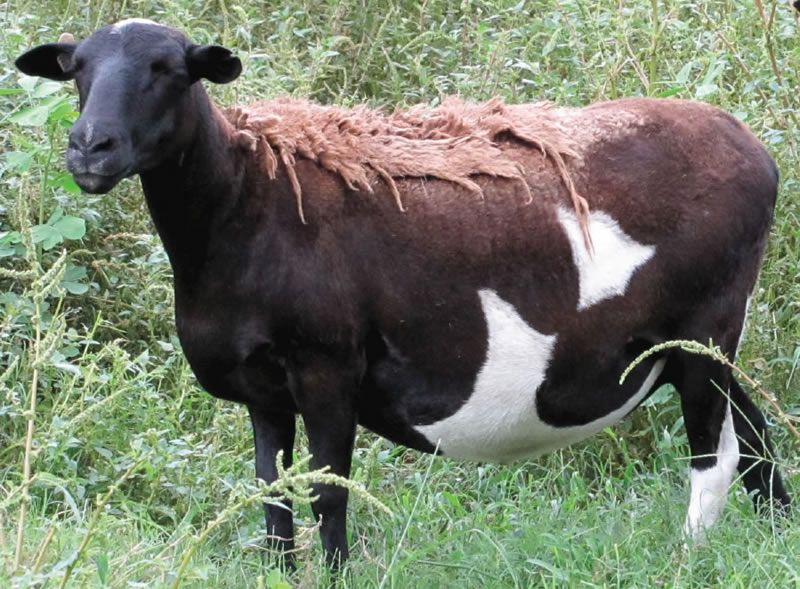
Credit: St. Augustine Hair Sheep Association
St. Augustine sheep were developed in Florida by Ron and Ruth Taber. This breed is a cross between St. Croix (5/8) and Dorper (3/8). St. Croix sheep have superior mothering abilities, parasite resistance, and hardiness. Dorper sheep are larger and have a heavy-muscled frame with excellent meat quality. The result is a meat sheep cross that does well in hot, humid conditions.
St. Augustine sheep are medium sized and are well adapted to hot, humid climates. They have good parasite resistance. They are easy to handle, with good flocking instinct. As excellent foragers, mature ewes and rams do well on pasture. Ewes are deep bodied, able to produce multiple births with ease. The St. Augustine breed consistently has twins and works well for an accelerated lambing schedule of every 8 months. They come in a variety of colors because of the St. Croix genetics. Most have hair that starts to fall off in February. Some have a strip of wool on the back from Dorper genetics.
Size: Medium.
Appearance: Color is often black and white throughout, while most have a wool and hair combination that will shed out annually.
Horns: Most are polled (no horns); occasionally will have horns or be scurred.
Behavior: Easy to handle with strong flock instincts.
Breeding season: Long breeding season, still short-day breeders.
Primary purpose: Meat.
Attributes: Developed for productivity in accelerated lambing programs; have a naturally shedding hair coat.
St. Croix
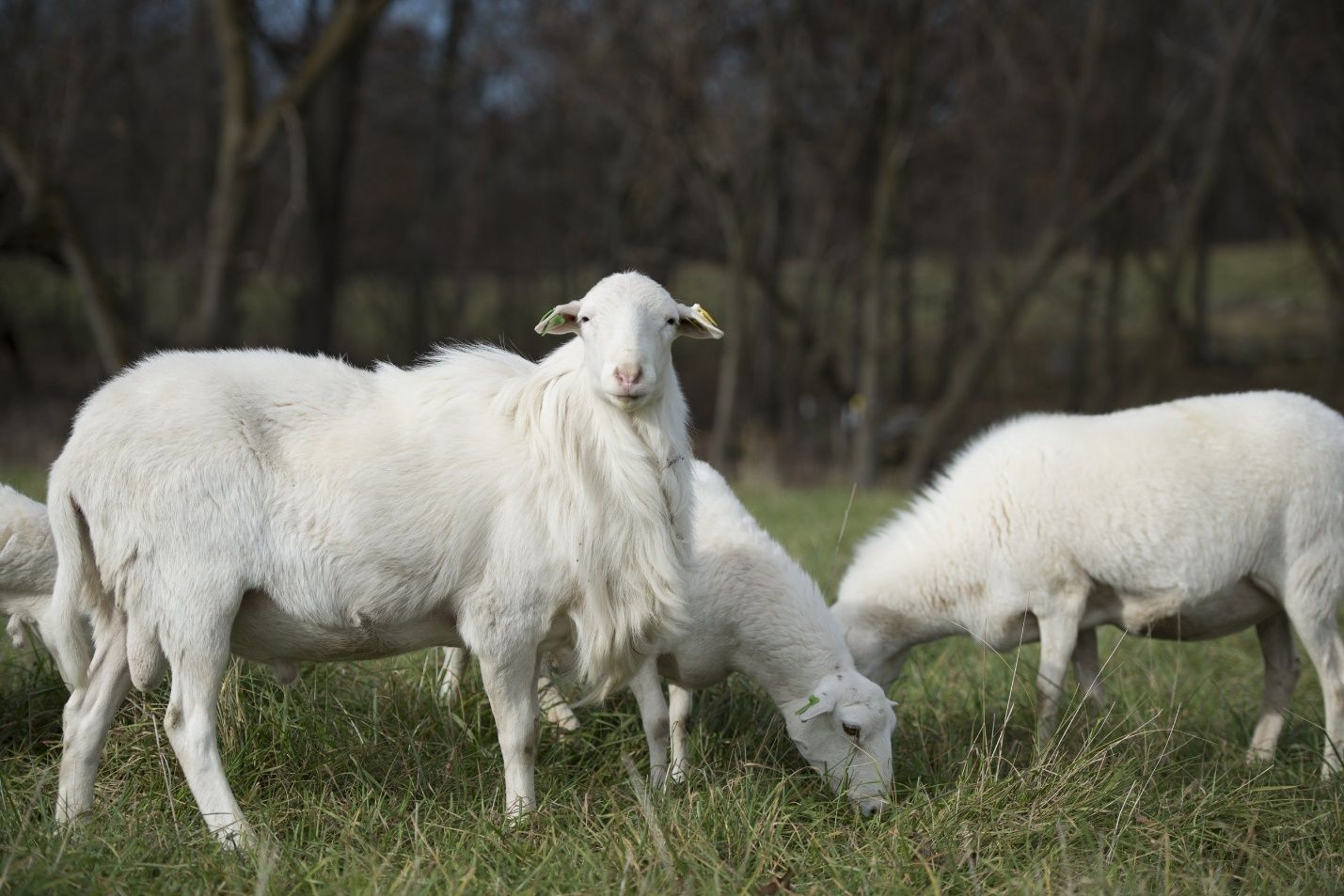
Credit: St. Croix Hair Sheep International Association
The St. Croix breed is a Caribbean breed, which was thought to have originated from hair sheep of West Africa. There is another theory that they developed from the Criollo sheep, native to the Caribbean, and the Wiltshire Horn. The Island White sheep were originally imported to the United States in 1975 and then developed into what is known as the St. Croix hair sheep today. The Island White sheep were used to develop this breed and were chosen for being polled and having a consistent white hair coat. Due to natural and human selection, these sheep are climate-adapted, fertile, and excellent foragers. Their browsing abilities make them useful for land management. They display good parasite resistance compared to many British sheep breeds. St. Croix sheep are a slow-growing breed; they are easy to handle, active, and vigorous. The ewes often can breed quickly after lambing and can produce two lamb crops per year. Lambs are usually multiples, with some singles. They are primarily a meat breed with meat that is tender and mild in flavor. They also produce milk that can be used to make dairy products.
Size: Small to medium.
Appearance: Most are all white, primarily with hair (no wool).
Horns: Polled (no horns).
Behavior: Good flocking instincts, often very alert but not unmanageable.
Breeding season: Non-seasonal (most can be bred year-round).
Primary purpose: Meat, milk.
Attributes: Are adaptable to most climates; known to have natural resistance to internal parasites; typically lamb with ease due to lower birth weights.
Keys to Selection
- Determine your goals as a producer for your sheep.
- Utilize the production goals you have set to aid in your breed selection criteria.
- Consider your facilities and pasture accommodations to determine attainable goals.
- Novice producers may not be fully prepared to raise breeds that commonly produce triplets or quadruplets, which would require more intensive management.
- Marketing strategies for your enterprise will directly affect the required inputs. Therefore, these factors should also be considered prior to determining which breed might be right for you.
The recommendations in this document are only guidelines, meant to aid producers in decision making. There are many other management strategies that play a role in an animal’s or breed’s success. Using a combination of management tools, maintaining records and utilizing them to make decisions, and utilizing a breed of sheep that has known innate parasite resistance qualities will create an avenue for success.
Conclusions
Using breeds that can survive and perform in the harsh climate of Florida is essential for sustainable sheep production in the state. The ability to naturally maintain low parasite burdens (natural parasite resistance) is one of the most important aspects of selection. Beyond these requirements, the choice of which breed is right for a producer comes down to the producer’s specific production goals and the tools that they have to achieve their goals.
References
American Dorper Sheep Breeders’ Society. 2024. “American Dorper Sheep Breeders’ Society.” https://dorpersheep.org/
Barbados Blackbelly Sheep Association International. 2024. “The International Registry for Barbados Blackbelly and American Blackbelly Sheep.” https://blackbellysheep.org/
Combs, W. 1983. “A History of the Barbados Blackbelly Sheep.” In Hair Sheep of Western Africa and the Americas, a Genetic Resource for the Tropics, edited by H. A. Fitzhugh and G. E. Bradford. 179–197. Boulder: Westview Press.
Dorper Sheep Breeders’ Society of South Africa. 2020. “Dorper Sheep Breeders’ Society of South Africa.” https://dorpersa.co.za/
Edwards, J. 2016. “The Florida Cracker Sheep Association.” https://floridacrackersheep.com/
Katahdin Hair Sheep International. 2024. “Katahdin Hair Sheep International.” https://katahdins.org/
Milne, C. 2000. “The History of the Dorper Sheep.” Small Rumin. Res. 36 (2): 99–102. https://doi.org/10.1016/S0921-4488(99)00154-6
National Sheep Improvement Program (NSIP). 2015. “National Sheep Improvement Program.” http://nsip.org/
Nilson, S. M., J. M. Burke, B. M. Murdoch, J. L. M. Morgan, and R. M. Lewis. 2024. “Pedigree Diversity and Implications for Genetic Selection of Katahdin Sheep.” J. Anim. Breed Genet. 141 (3): 304–316. https://doi.org/10.1111/jbg.12842
St. Augustine Hair Sheep Association. 2024. “St. Augustine Hair Sheep Association.” https://staugustinehairsheep.com/
St. Croix Hair Sheep International Association. 2024. “St. Croix Hair Sheep International Association.” https://stcroixhairsheep.org/
The Livestock Conservancy. 2020. “The Livestock Conservancy.” https://livestockconservancy.org/